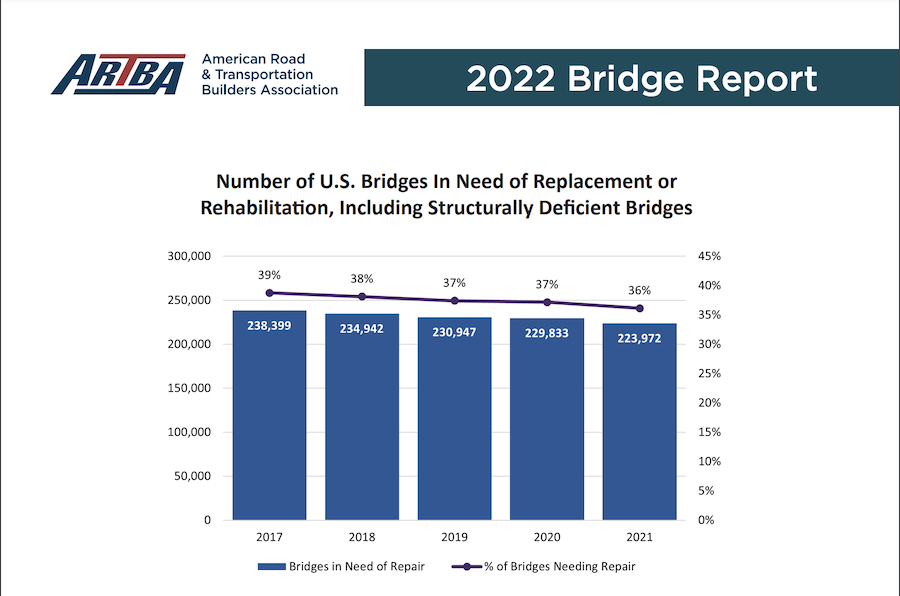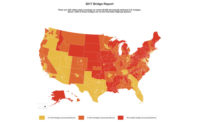States are making progress in reducing the number of deficient bridges—those rated in “poor” condition— but still have a huge backlog of work remaining, according to a new American Road & Transportation Builders Association analysis.
The ARTBA report, released Feb. 2, is an analysis of data contained in the Federal Highway Administration’s (FHWA) National Bridge Inventory, which totaled 619,588 bridges as of 2021. ARTBA says about 224,000 bridges need repairs. Of those, 43,578 are categorized as structurally deficient, including the Fern Hollow Bridge that collapsed in Pittsburgh on Jan. 28.
ARTBA estimates that carrying out repairs on all of those 224,000 bridges would cost $260 billion. The report says that last year, the number of structurally deficient bridges declined by 1,445, or 3.2%, from the 2020 level.
But the association said that at that rate of improvement, it would take 30 years to fix all of the bridges that need repairs.
Pennsylvania, which has been a focus of attention since the bridge collapse, has 23,166 bridges, of which 3,198, or 13.8%, are in poor condition or worse, according to the report. The state also has reduced its number of structurally deficient bridges by 4,147 since 2017,
Bridge inspections rate structural components, including decks, superstructure and substructure on a scale of 1 to 9, with 9 being excellent and 1 indicating “imminent failure,” according to ARTBA. A rating of 4 or lower for any key element puts a bridge in “poor” condition overall.
Restraints on Funding
The release of the ARTBA report comes as Congress is facing the Feb 18 expiration of a stopgap appropriations bill.
That stopgap’s limit on highway obligations, based on 2021 levels, has prevented state transportation departments from being able to obligate the full amount of increased highway funding authorized in the Infrastructure Investment and Jobs Act (IIJA).
ARTBA and other transportation and construction groups have been pushing Congress to pass a new appropriations measure extending through the end of fiscal 2022 that would include the IIJA’s higher highway funding totals.
The top appropriators from both parties and both houses of Congress have been discussing a full-year spending package. And Senate Majority Leader Chuck Schumer (D-N.Y.) said in a Feb. 2 statement that those lawmakers were scheduled to meet again later that day.
Still, an agreement doesn’t appear close at hand.
Dave Bauer, ARTBA president and chief executive officer, said in a statement, “The longer it takes to bridge the political divide on the FY 2022 spending bills, the longer it will take for transportation improvements to get started.”
Bauer urged Congress “to act forthwith so that the American people can begin to realize the benefits of the historic investments in the bipartisan infrastructure law.”
Besides the large amount of multi-purpose IIJA highway money that has been distributed by formula, the massive infrastructure package also has two new programs targeted specifically to bridge work.
FHWA on Jan. 14 already apportioned to states the $5.3 billion 2022 installment of the IIJA’s new five-year, $27-billion Formula Bridge Program. A senior Biden administration official has said that the Formula Bridge Program is expected to repair or upgrade up to 15,000 of the 43,000-plus bridges in poor condition—or what the ARTBA report terms structurally deficient.
What’s more, that $5.3 billion is “available for obligation immediately and are not subject to any limitation on obligations,” Deputy Federal Highway Administrator Stephanie Pollack said.
The other bridge program, for which U.S. DOT will select the winning projects, totals $12.5 billion over five years.
But that program, as expected, has yet to get off the ground, because DOT must develop the application procedures, selection criteria and timetable for the competition. Then it must call for applications, evaluate them and pick the winners.




Post a comment to this article
Report Abusive Comment